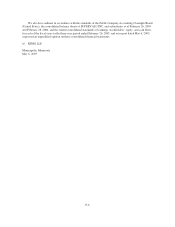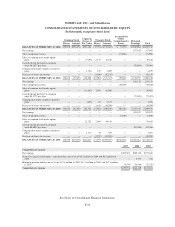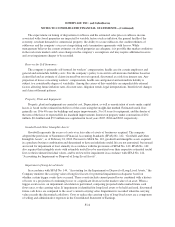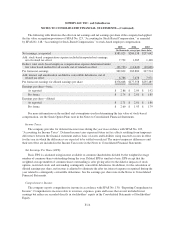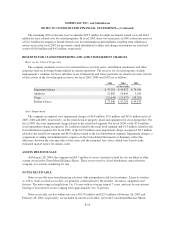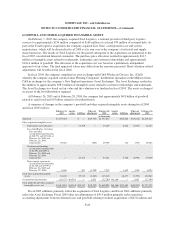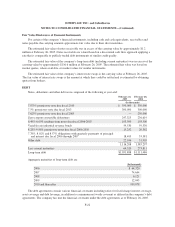Albertsons 2005 Annual Report Download - page 60
Download and view the complete annual report
Please find page 60 of the 2005 Albertsons annual report below. You can navigate through the pages in the report by either clicking on the pages listed below, or by using the keyword search tool below to find specific information within the annual report.SUPERVALU INC. and Subsidiaries
NOTES TO CONSOLIDATED FINANCIAL STATEMENTS—(Continued)
The expectations on timing of disposition or sublease and the estimated sales price or sublease income
associated with closed properties are impacted by variable factors such as inflation, the general health of the
economy, resultant demand for commercial property, the ability to secure subleases, the creditworthiness of
sublessees and the company’s success at negotiating early termination agreements with lessors. While
management believes the current estimates on closed properties are adequate, it is possible that market conditions
in the real estate market could cause changes in the company’s assumptions and may require additional reserves
and asset impairment charges to be recorded.
Reserves for Self Insurance:
The company is primarily self-insured for workers’ compensation, health care for certain employees and
general and automobile liability costs. It is the company’s policy to record its self-insurance liabilities based on
claims filed and an estimate of claims incurred but not yet reported, discounted at a risk free interest rate. Any
projection of losses concerning workers’ compensation, health care and general and automobile liability is
subject to a considerable degree of variability. Among the causes of this variability are unpredictable external
factors affecting future inflation rates, discount rates, litigation trends, legal interpretations, benefit level changes
and claim settlement patterns.
Property, Plant and Equipment:
Property, plant and equipment are carried at cost. Depreciation, as well as amortization of assets under capital
leases, is based on the estimated useful lives of the assets using the straight-line method. Estimated useful lives
generally are 10 to 40 years for buildings and major improvements, 3 to 10 years for equipment, and the shorter of
the term of the lease or expected life for leasehold improvements. Interest on property under construction of $0.2
million, $0.4 million and $5.9 million was capitalized in fiscal years 2005, 2004 and 2003, respectively.
Goodwill and Other Intangible Assets:
Goodwill represents the excess of costs over fair value of assets of businesses acquired. The company
adopted the provisions of Statement of Financial Accounting Standards (SFAS) No. 142, “Goodwill and Other
Intangible Assets”, as of February 24, 2002. Pursuant to SFAS No. 142, goodwill and intangible assets acquired
in a purchase business combination and determined to have an indefinite useful life are not amortized, but instead
are tested for impairment at least annually in accordance with the provisions of SFAS No. 142. SFAS No. 142
also requires that intangible assets with estimable useful lives be amortized over their respective estimated useful
lives to their estimated residual values, and be reviewed for impairment in accordance with SFAS No. 144,
“Accounting for Impairment or Disposal of Long-Lived Assets”.
Impairment of Long-Lived Assets:
In accordance with SFAS No. 144, “Accounting for the Impairment or Disposal of Long-Lived Assets,” the
Company monitors the carrying value of long-lived assets for potential impairment each quarter based on
whether certain trigger events have occurred. These events include current period losses combined with a history
of losses or a projection of continuing losses or a significant decrease in the market value of an asset. When a
trigger event occurs, an impairment calculation is performed, comparing projected undiscounted future cash
flows rates, to the carrying value. If impairment is identified for long-lived assets to be held and used, discounted
future cash flows are compared to the asset’s current carrying value. Impairment is recorded when the carrying
value exceeds the discounted cash flows. Costs to reduce the carrying value of long-lived assets are a component
of selling and administrative expenses in the Consolidated Statement of Earnings.
F-14




